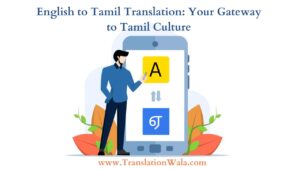In the modern, linked world, where there is no limit to the amount of communication that may take place, the demand for accurate and effective interpretation across different dialects is crucial.
The translation from English to Tamil is one of the most important interpretation pairs. It is very necessary to have a method of interpretation that is consistent since Tamil has such a rich social past and is used in such a broad variety of contexts.
This article on the blog delves into the complications of English to Tamil Translation, including its challenges as well as the relevance it has in a variety of contexts.
Figuring out the Importance
The Variety of the Tamil Language
One of the most experienced dialects, Tamil has a collection of experiences spanning millennia, which has resulted in a variety of varied reach vernaculars and phonetic peculiarities.
Because Tamil has maintained its recognizable character over the ages, from ancient text to modern media, accurate interpretation is required to ensure that one is able to comprehend the gist of the subject matter.
Social Safeguarding
Because language and culture are inextricably linked, translating from English to Tamil does not simply consist of exchanging one set of words for another while simultaneously preserving the original context.
When it comes to writing, rigid texts, or verified documents, precise interpretation is the only way to ensure that the social and close to home perspectives are maintained in their entirety.
Challenges in Translation
Semantic Subtleties
The Tamil language has a plethora of linguistic subtleties, which usually create a challenge when attempting to comprehend.
It’s possible that certain English terms and phrases don’t have exact equivalents in Tamil, which means that translators will need to use their creativity to make adjustments while maintaining the intended meaning.
Context oriented Variation
The process of deciphering involves more than simply figuring out what the words mean; it also involves communicating the intended message. It is vital to modify the content in accordance with the social and social milieu of the interest group.
If you want a term to make sense to people who speak Tamil and it already sounds OK in English, you may want to entirely rework it.
Specialized and Language Translation
The need for accurate interpretation is not limited to literary or creative works; technical material and language-heavy records also need interpretation.
The delicate balance that must be maintained by interpreters in order to ensure semantic and logical comprehension while still keeping up with the specialized accuracy of the language being interpreted.
Also Read: Opening the Magnificence of English to Punjabi Translation – Overcoming any barrier through Language

The Craft of Translation
Transcription: Beyond anything describable
The process of transcription goes beyond than literal interpretation. It involves replicating the personal affect, tone, and style of the material in an objective language.
This cycle is especially important when it comes to advertising and disseminating items since social reverberation directly determines how appropriate something is.
The Human Touch
Even while mechanical equipment may be used to enhance interpretation, there is no substitute for the human touch. Local Tamil interpreters who have a strong grasp of the two languages are able to investigate complexities and nuances that may be missed by automated programming.

Website design enhancement Advancement for English to Tamil Translation Administrations
Watchword Coordination
The English to Tamil Translation services need to have vital watchwords like “English to Tamil interpretation,” “competent Tamil interpretation,” and a few others like these for the purpose of expanding their perceivability.
When customers search the internet for interpretation assistance, this ensures that the service will come up higher in the search results.
Conclusion:
English to Tamil Translation isn’t only an exercise in etymology, it’s also a framework that connects different civilizations, ways of thinking, and emotions.
It is a display of the mastery and knowledge that qualified interpreters give that would be beneficial that they can protect the legitimacy of the material while also ensuring that it reverberates with the population that speaks Tamil.
The task of accurate interpretation will continue to be essential in promoting mutual understanding and cohesion among speakers of different languages as our world becomes more compact as a result of more sophisticated connections.



